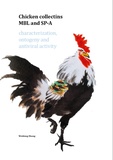Chicken collectins MBL and SP-A
Characterization, ontogeny and antiviral activity

Zhang, Weidong
- Promoter:
- Prof.dr. H.P. (Henk) Haagsman
- Co-promoter:
- Dr. E.J.A. (Edwin) Veldhuizen
- Research group:
- Haagsman
- Date:
- September 21, 2016
- Time:
- 14:30 h
Summary
Collectins, key molecules of the innate immune system, are a group of oligomeric proteins mainly found in lung and serum. Collectins belong to C-type (Ca2+ -dependent) lectin family, characterized by a collagenous domain and a carbohydrate recognition domain. By binding to the sugar patterns present on the surface of pathogens, collectins are able to aggregate and therefore inhibit pathogen infectivity. In this dissertation, we described two chicken collectins, cMBL and cSP-A. First, the regulation of collectin expression during the development of the chicken was investigated, in which cSP-A gene expression levels showed a strong increase during the embryonic development, peaking at the day of hatch and remained stable until four weeks post-hatch. Furthermore, the localization of cSP-A was determined, and was found to be exclusively present in the lung, similar to mammalian SP-A. Specific epithelial cells produce cSP-A, after which it is secreted in a thin water layer on top of the epithelial surface in the lung. These results suggest that cSP-A have an immune function against respiratory pathogens. Next, the cMBL protein was recombinantly expressed and characterized. The recombinant cMBL forms oligomeric structures similar to mammalian MBL. Further biophysical and biological characterization showed that the recombinant cMBL had similar characteristics to native cMBL, which provides an excellent tool to study further functions of cMBL. The following study zoomed in on the protective function of cMBL against infectious bronchitis virus (IBV). In vitro studies showed that cMBL was able to block the infection by IBV-Beaudette of BHK cells in a concentration dependent manner. The ability of cMBL to block the infection was due to a direct interaction with IBV which agglutinated into clumps in the presence of cMBL. This interaction was further confirmed by binding of cMBL to the spike protein of virus. Last, cSP-A was isolated form bronchoalveolar lavage fluid (BALF) and confirmed by immunoblot as a doublet with a molecular weight of approximately 26 kDa under reducing conditions, comparable to cSP-A detected in lung homogenate. cSP-A is an N-linked glycosylated protein as determined by treatment with PNGase F which caused a reduction in mass of approximately 4 kDa. The successful use of mannan or galactose coated beads to obtain cSP-A from BALF indicated that it is indeed a true C-type lectin with Ca2+ -dependent binding affinity for glycan. However, the incapability to purify cSP-A in sufficient purity and amounts hindered a full characterization of this protein. In summary, this dissertation presents the first step of functional description of collectins in chicken.